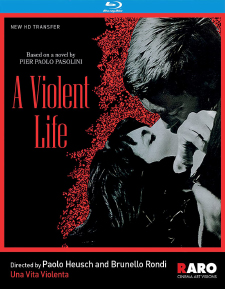Violent Life, A (Blu-ray Review)

Director
Paolo Heusch, Brunello RondiRelease Date(s)
1962 (January 31, 2023)Studio(s)
Aera Films/Zebra Films (Raro Video/Kino Lorber)- Film/Program Grade: A-
- Video Grade: A-
- Audio Grade: B+
- Extras Grade: B+
Review
Though it falls short of greatness, A Violent Life (Una vita violenta), adapted from a novel by Pier Paolo Pasolini, has plenty to offer. The film is rather like Akira Kurosawa’s Drunken Angel (1948) minus Takashi Shimura’s doctor character. Franco Citti stars as a low-level hood stubbornly clinging to his machismo even after contracting tuberculosis, much like Toshiro Mifune’s character in Kurosawa’s film. This film, however, co-directed by Paolo Heusch and Brunello Rondi, is more overtly political, and it offers unique and interesting scenes of postwar Italy slum life.
Tommaso (Citti) is the leader of a vaguely neo-fascist street gang—one member even keeps a photo of Mussolini in his wallet—that, conversely, all hang out at the community center built by local members of the Italian Communist Party. They pick up and girls and stir up trouble with their far-right views (“At least Mussolini got things done! He was a real man!”), but mostly aimlessly steal cars and rob petrol stations, terrorizing total strangers, including gang-raping a French woman. Tommaso meets “good girl” Irene (Serena Vergano, very pretty, with an innocence similar to Olivia Hussey), talking her into seeing the latest Hercules movie, but he’s only interested in making out while she wants to watch the film. (Curiously, the movie-within-the-film is shown in flat 1.37:1 rather than ‘scope. Were older Italian cinemas still unconverted to widescreen at this time?)
Tommaso is shaken when another member of the gang loses his leg in a streetcar accident, later becoming homeless, and after Tommaso is arrested, serving an 18-month stretch in the slammer. Upon his release, he’s surprised to discover that his family has moved out of the slum and, with government assistance and a leg up from the Catholic Church, into a modern apartment building. Irene, surprisingly, is ready to renew her burgeoning if long-stalled relationship, and though Tommaso begins falling back on his old ways, the future looks vaguely optimistic—until he begins coughing up blood.
While A Violent Life shares many elements in common with Pasolini’s early work, notably the casting of frequent actor Franco Citti, Pasolini himself was quick to say that the film wasn’t his and was not involved in its production, though he was pleased with how it came out. Similar story-wise to Pasolini’s debut feature, Accattone (1961), with Citti playing a pimp, critics generally regarded A Violent Life as a no-better-than-okay imitation. The fact that co-director Heusch was a lowly genre director (his credits including The Day the Sky Exploded, Italy’s first sci-fi feature, and Werewolf in a Girls’ Dormitory) was further proof of the picture’s bastardized status in the eyes of many. (Rondi was better known as a screenwriter, his credits including collaborating on many of Fellini’s best films.)
But the film does a fine job capturing the milieu of Rome’s lower-class, seemingly left behind as the country reimagined itself in the decades following World War II. Throughout the picture are uniquely memorable sequences: at the Communist-run community hall; the gang’s violent rampage, some of it contrasting with ultra-modern architecture in more fashionable parts of Rome; Tommaso’s stay at a dire, government-run, Kafka-esque hospital which becomes overrun with militarized police and communist/union strikers (the latter hiding out when the strike turns violent); and the flooding of a shantytown, with Tommaso trying to rescue a woman in neck-deep water.
The cinematography by Armando Nannuzzi—whose diverse (to say the least) credits include Visconti’s The Damned, Bondarchuk’s Waterloo, La Cage aux Folles, and Maximum Overdrive—infuses the film with a semi-documentary air. Numerous art and property department personnel are credited in the main titles, but all the locations all seem real; nothing looks like a film set.
The excellent booklet essays detail the film’s production while exploring the contributions of each credited director (the consensus concluding that Rondi was the primary one) and to what degree, if at all, the film was influenced by Accattone (Rondi claims his film was completed before Pasolini’s went into production, despite that one reaching theaters first).
Raro Video’s Blu-ray disc of A Violent Life is Region-Free. The film was an Italian-French co-production, which probably accounts for the 1.66:1 widescreen aspect ratio (standard in France but not Italy, which favors 1.85:1). The black-and-white film looks excellent throughout, the 1080p image perhaps a little more washed out and grayish than some might like, but an accurate, clean rendering nonetheless. (The image sources an Italian restoration of several years ago.) The Italian DTS-HD Master Audio (2.0 mono) is likewise excellent (except for some distortion on the music track in the final seconds of the film), supported by excellent English subtitles for the Italian dialogue.
A superb 16-page insert booklet accompanies the disc, featuring essays by Alberto Pezzotta, Bruno Di Marino, comments by Rondi, a Report from the Set, quotes from contemporary reviews and short bios of the filmmakers. (Whomever wrote the latter seems to think Heusch is still living. He’s not, having died in 1982.) Also included are three featurettes, interviews with director Luciano Emmer (5:50), film historian Stefania Parigi (6:38), and critic Umberto Rondi (10:38). Given that so much of A Violent Life revolves around time and place-specific concerns, these extras do a fine job putting everything into historical context.
They also make a strong case that A Violent Life is a long-unjustly dismissed film worth reappraisal. And they’re right—it’s a picture with many fine qualities well worth seeing.
- Stuart Galbraith IV

